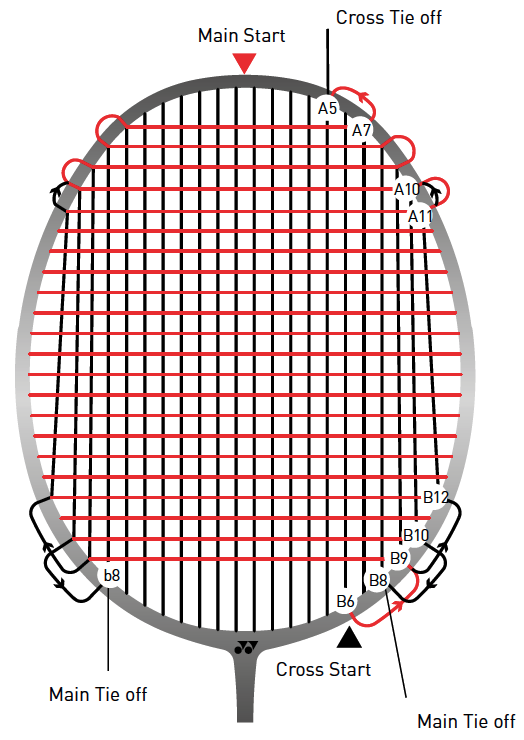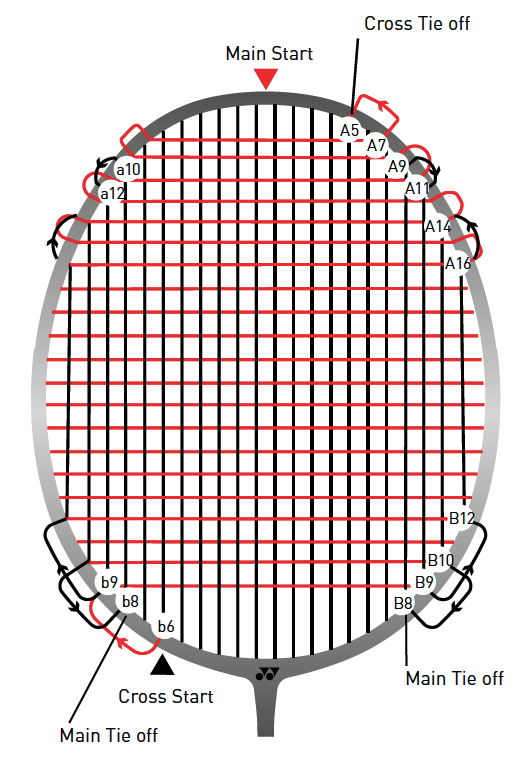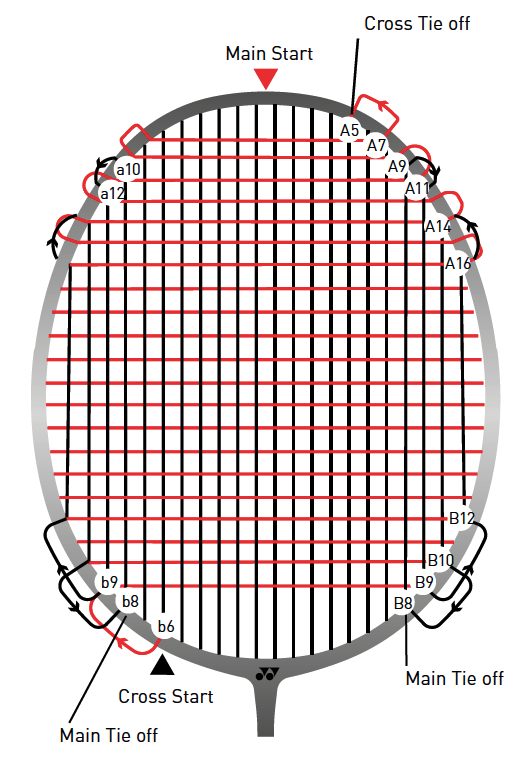Restringing a badminton racquet can seem tough. It’s a crucial skill for any player.
Understanding how to restring your racquet ensures you maintain its optimal performance. Regular restringing helps keep your shots accurate and powerful. Over time, strings lose tension and wear out, affecting gameplay. Knowing when and how to replace them can enhance your game.
This guide will take you through the steps to restring your racquet. Whether you are a beginner or an experienced player, learning this skill will benefit you. Let’s dive into the process and keep your racquet in top shape for every match!

Credit: www.badmintonbay.com
Choosing The Right String
Choosing the right string for your badminton racquet can make a big difference. It affects your performance and the feel of your game. A good string can enhance your shots and provide better control. In this section, we’ll explore types of strings and string tension to help you make the best choice.
Types Of Strings
There are different types of badminton strings. Each type has unique features. Here are the main types:
Natural Gut Strings: These strings are made from animal intestines. They offer excellent feel and control. They are often preferred by professional players.
Multifilament Strings: These are made from multiple fibers woven together. They provide good power and comfort. They are a popular choice among intermediate players.
Monofilament Strings: These strings are made from a single strand of material. They offer durability and control. They are suitable for players who prefer a firm feel.
String Tension
String tension is the tightness of the strings on your racquet. It impacts your play style and performance. Here are some key points:
High Tension: Higher tension provides better control and precision. It suits advanced players with good technique. However, it reduces power and can cause arm strain.
Low Tension: Lower tension offers more power and a larger sweet spot. It is ideal for beginners and players who want more forgiveness. It can, however, reduce control.
Choosing the right string tension depends on your skill level and playing style. Experiment with different tensions to find your perfect match.

Credit: www.ifixit.com
Preparing The Racquet
Restringing a badminton racquet involves several steps. The first step is preparing the racquet. This ensures a smooth restringing process. Let’s dive into the details.
Removing Old Strings
Start by cutting the old strings. Use a sharp pair of scissors. Cut the strings in the center of the racquet. Then, work your way outwards. This releases the tension evenly. Avoid pulling the strings out forcefully. Gently remove them from the frame. This prevents any damage to the racquet.
Inspecting The Frame
Once the strings are removed, inspect the frame. Look for any cracks or damage. Check the grommets as well. These are the small plastic pieces that protect the strings. Make sure none are missing or worn out. If you find any damage, repair it before restringing. This ensures the racquet is safe to use. A thorough inspection helps in maintaining the racquet’s longevity.
Setting Up The Stringing Machine
Restringing a badminton racquet might seem like a daunting task. With the right tools and steps, it becomes manageable. One critical step is setting up the stringing machine. This ensures the racquet is secure and the strings are tight. Follow these steps to set up your stringing machine correctly.
Mounting The Racquet
First, place the racquet on the machine’s mount. Make sure the head and throat are secure. Use the adjustable clamps to hold the racquet in place. Check that it does not move when you apply pressure. This ensures even tension while stringing.
Adjusting Tension Settings
Next, set the desired tension on the machine. Look at the manufacturer’s recommendation for your racquet. Use the machine’s dial or digital setting to adjust the tension. Double-check the settings before you start stringing. This step is crucial for consistent string tension.

Credit: www.youtube.com
Stringing The Mains
Stringing the mains is a crucial part of restringing a badminton racquet. It involves threading the main strings vertically through the racquet’s frame. This step ensures that your racquet has the right tension and durability for optimal performance. Below, we will guide you through the process.
Starting The Mains
To begin, you need to secure the string to the racquet. Follow these steps:
- Insert the string through the middle holes at the top of the racquet.
- Pull the string through until you have equal lengths on both sides.
- Secure one end of the string with a clamp to hold it in place.
- Begin threading the other end of the string through the opposite middle hole.
- Pull the string tight and clamp it to maintain tension.
Repeat this process for the remaining main strings, ensuring each string is tight and secure.
Weaving The Mains
Weaving the mains involves threading the strings through the racquet’s frame in an alternating pattern. Follow these steps:
- Start with the first string and weave it over and under the cross strings.
- Continue this pattern until you reach the bottom of the racquet.
- Pull the string tight and clamp it to keep the tension consistent.
- Move to the next string and repeat the over and under pattern.
- Ensure each string is parallel to the previous one and maintains the same tension.
Proper weaving ensures the racquet’s strength and performance. Take your time to ensure accuracy.
Stringing The Crosses
Restringing a badminton racquet can seem like a daunting task. But with the right guidance, it becomes manageable. Once you have strung the mains, it is time to move to the crosses. This part involves weaving the string horizontally through the vertical mains. It is essential to do this correctly to ensure the racquet performs well.
Starting The Crosses
Begin by securing the string at the top of the racquet. Use a starting knot to hold it in place. Make sure it is tight. This prevents any slipping when you start weaving.
Next, insert the string into the first top grommet. Pull it through to the other side. Ensure that the string is straight and not twisted. This provides a strong foundation for the rest of the crosses.
Weaving The Crosses
Weaving the crosses is a repetitive but crucial process. Start by passing the string over and under each main string. This creates a woven pattern. Pay attention to the tension. It should be consistent throughout the process.
Here is a simple guide:
- Pass the string over the first main.
- Go under the second main.
- Repeat this pattern till you reach the end.
When you reach the end of a row, pull the string tight. Then, move to the next row. Continue weaving in the opposite pattern. If you went over a main in the previous row, go under it in the next.
Remember these tips:
- Keep the tension even.
- Avoid twists in the string.
- Check each row for consistency.
Taking care during this step ensures your racquet performs at its best. Properly woven strings can improve your game by providing better control and power.
Tying Off Knots
Tying off knots is a crucial step in restringing a badminton racquet. Proper knots ensure that the strings stay tight and secure during play. This section will guide you through securing mains knots and crosses knots.
Securing Mains Knots
Start by pulling the string tight through the last main hole. This ensures that there is no slack. Make a loop with the string and thread it through the nearest grommet. Pull it tight to form a basic knot. Repeat the loop and threading process to create a double knot. This adds extra security. Trim any excess string close to the knot. This prevents it from interfering with play.
Securing Crosses Knots
After stringing the crosses, pull the string tight through the last cross hole. Again, make sure there is no slack. Create a loop and thread it through a nearby grommet. Pull it tight to form a basic knot. Repeat the process to make a double knot. This ensures the knot is secure. Trim the excess string close to the knot. This keeps the racquet neat and ready for use.
Final Adjustments
After you have threaded the strings through your badminton racquet, some final adjustments are necessary. These steps ensure that your racquet performs well during matches. Paying attention to these details can help improve your gameplay and racquet longevity.
Trimming Excess String
Look at your racquet closely. Check for any extra string hanging out. Use a pair of sharp scissors. Cut off the excess string carefully. Leave a small margin of about half an inch. This prevents the string from slipping out.
Be precise with your cuts. Uneven strings can affect the tension. They can also create a messy look. Always use good quality scissors. Blunt scissors can fray the string.
Checking String Tension
Ensure the string tension is even across the racquet. Press the strings gently with your thumb. They should feel firm, not loose. Use a string tension meter for accuracy. This tool helps you measure the exact tension.
Adjust if you find any loose strings. Tighten them carefully. Do not over-tighten. This can cause the string to break. Balanced tension is key. It affects your shots and overall performance.
By making these final adjustments, you ensure your racquet is match-ready. Happy playing!
Maintenance Tips
Maintaining your badminton racquet is essential for a better game. Proper care ensures the racquet performs well and lasts longer. Below are some key tips to help you maintain your racquet.
String Care
The strings of your badminton racquet are crucial for performance. Proper care can extend their lifespan.
- Avoid wet conditions. Moisture weakens the strings over time.
- Store in a cool, dry place. Extreme temperatures can damage the strings.
- Use a racquet cover. This protects the strings from dust and damage.
When To Restring
Knowing when to restring your racquet is important. It ensures optimal performance.
| Signs | Description |
|---|---|
| Fraying strings | Strings look worn out and may break soon. |
| Loss of tension | Strings feel loose and lack the usual bounce. |
| Reduced control | Harder to control the shuttlecock. |
Restring your racquet if any of these signs appear. Regular players should restring every 3-6 months. Casual players can restring every 6-12 months.
Frequently Asked Questions
How Often Should I Restring My Badminton Racquet?
It depends on how frequently you play. Regular players should restring every 3 months. Casual players can restring every 6 months.
What String Tension Is Best For Badminton Racquets?
For beginners, 18-23 lbs is ideal. Advanced players may prefer 24-30 lbs. Higher tension offers better control.
Can I Restring My Badminton Racquet Myself?
Yes, you can. However, it requires proper tools and knowledge. It’s often best to visit a professional.
What Type Of Strings Should I Use?
Nylon strings are durable and affordable. Professional players often prefer multifilament strings for better performance and feel.
Conclusion
Restringing a badminton racquet can seem tricky at first. With practice, it becomes easier. Remember to follow each step carefully. Use the right tools and strings. Take your time. Your effort will pay off with better game performance. A well-strung racquet improves your control and power.
Enjoy your game with your newly strung racquet. Happy playing!



